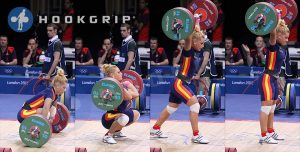Olympic Weightlifting and Physical Therapy Rehabilitation
 When the Olympic Games took place this past summer in Tokyo, the world watched as global competitors participated in one of the oldest Olympic Games events, Olympic weightlifting. While many view Olympic weightlifting as only for the ultra-strong, physical therapist Tyler Lang, PT, DPT, has a different take on the sport.
When the Olympic Games took place this past summer in Tokyo, the world watched as global competitors participated in one of the oldest Olympic Games events, Olympic weightlifting. While many view Olympic weightlifting as only for the ultra-strong, physical therapist Tyler Lang, PT, DPT, has a different take on the sport.
Lang, a Certified Olympic Weightlifting Coach, works at the Orthopaedic Hospital of Wisconsin’s Cedarburg Physical Therapy Clinic. He utilizes the valuable lessons he learned from Olympic weightlifting and applies them to how he treats patients, bridging the gap between typical physical therapy exercises and the skills acquired during weight training.
A Brief History of Olympic Weightlifting
What is Olympic weightlifting? Olympic weightlifting consists of two main lifts, the snatch and the clean and jerk. The snatch is a lift that requires the athlete to lift a weighted bar in one single motion from the floor to overhead.

photo credit: hookgrip
The clean and jerk lift requires the athlete to lift the weighted bar from the floor, catch the bar in front of the body on the shoulders and then press the weighted bar overhead.

photo credit: hookgrip
While this is what Olympic weightlifting looks like today, the sport has a history as long as the Olympic Games itself.
The very first Olympic Games took place in 1896 in Athens, Greece. When Olympic weightlifting began, it looked a bit different than it does today. The original two lifts that Olympic weightlifters performed were the one-handed lift and the two-handed lift. Additionally, there were no weight classes. All competitors, despite their size, competed against each other. Further, all competitors were men.
Eventually, a call for keeping the game fair brought changes to the competition. Weightlifters with smaller body frames and weights were often at a disadvantage for the total weight they could lift compared to their larger and heavier counterparts. There were also no regulations on the lifter’s body mechanics when lifting the weight. If they could raise the weight from the ground to overhead, judges accepted the lift.
In the 1920 Olympic Games, the Olympic Committee developed five different weight classes for competitors. At this time, the lifts that judges were limited to five lifting techniques which were defined and classified. This included the one-handed snatch, the one-handed clean and jerk, and the two-handed clean and jerk. In the 1924 Games, the two-handed snatch and the two-handed clean and press were added as well.
At the 1972 Olympics, the Olympic Committee further narrowed down the Olympic lifts to the snatch and clean, jerk, and the jerk requiring the lifter to use two hands to lift a weighted barbell. The clean and press lift was officially omitted from the competition due to increasing injuries and difficulty judging.
Finally, in the 2000 Olympic Games in Sydney, Australia, women were allowed to participate in Olympic weightlifting.
Personal Experience with Olympic Weightlifting
Lang’s passion for Olympic weightlifting began while developing his interest in lifting weights, bodybuilding, and powerlifting. While attending the University of Wisconsin La Crosse for his undergraduate studies, he began frequenting the campus gym. He also became a member of the university’s Olympic weightlifting club.
“The sport of Olympic weightlifting was completely foreign to me, but I was fascinated by how the Olympic lifters could lift the weight from the floor to overhead with such coordination, power, and strength,” Lang said. “Once I joined the Olympic weightlifting club, I haven’t looked back!”
Lang now has eight years of experience being an Olympic weightlifter, and he regularly incorporates his passion for the sport into his physical fitness routine.
Using Olympic Weightlifting as Physical Therapy
Lang credits his experience as an Olympic weightlifter as a part of what shapes his treatment plans for his patients as a physical therapist.
“Even though there are only two lifts in Olympic weightlifting, there are endless amounts of exercises within Olympic weightlifting that a physical therapist can use in practice,” Lang said. “Each lift has a multistep process that requires the technical use of various muscle groups.”
Lang says he uses exercise from Olympic weightlifting with most of his patients, whether they’re an athlete or a member of the general public. From using the entire lift or portions of each lift, there are elements of lifting that can help to address deficits patients are struggling with, such as mobility, strength, power, coordination, balance, and posture.
“While having patients perform the entirety of a lift, I don’t always have them use a heavily weighted barbell. Sometimes I get creative with the equipment and tools available at the clinic to teach the lift movements. I’ll often use a PVC pipe, a broomstick, a cane, dumbbells, and kettlebells,” Lang explained. “The focus is often on improving their coordination, posture, form, and balance rather than increasing their strength and power.”
Lang says that most of his patients enjoy this new rehabilitation experience due to the complexity and challenge it presents, and they are always looking forward to the following physical therapy session.
Please reach out today if you’re hoping to schedule an appointment with Tyler Lang, PT, DPT, or any of our physical therapy team at the Orthopaedic Hospital of Wisconsin. Our team can help you get back into your best gold-medal shape and restore comfortable mobility.

